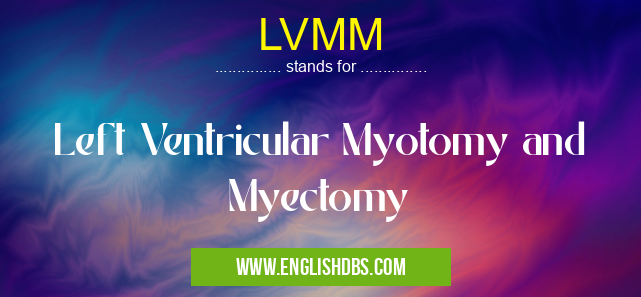What does LVMM mean in CARDIOLOGY
LVMM (Left Ventricular Myotomy and Myectomy) is a surgical procedure used to treat a condition known as hypertrophic cardiomyopathy (HCM). HCM is a condition in which the heart muscle becomes thickened, making it harder for the heart to pump blood effectively.

LVMM meaning in Cardiology in Medical
LVMM mostly used in an acronym Cardiology in Category Medical that means Left Ventricular Myotomy and Myectomy
Shorthand: LVMM,
Full Form: Left Ventricular Myotomy and Myectomy
For more information of "Left Ventricular Myotomy and Myectomy", see the section below.
» Medical » Cardiology
LVMM Procedure
LVMM involves making an incision in the thickened portion of the heart muscle (the left ventricle) and removing a small amount of tissue. This creates a channel that allows blood to flow more easily out of the left ventricle.
Key Points
- Purpose: To relieve obstruction and improve blood flow in patients with HCM.
- Technique: Open-heart surgery that involves creating a channel in the thickened heart muscle.
- Indications: Severe HCM that causes significant symptoms, such as shortness of breath, chest pain, or fainting.
- Benefits: Improved heart function, reduced symptoms, and increased life expectancy.
Advantages of LVMM
- Improved Heart Function: LVMM can significantly improve the heart's ability to pump blood, reducing symptoms such as shortness of breath and fatigue.
- Reduced Symptoms: By relieving the obstruction caused by the thickened muscle, LVMM can alleviate symptoms such as chest pain, palpitations, and fainting spells.
- Increased Life Expectancy: LVMM has been shown to improve survival rates for patients with HCM who have severe symptoms or who are at high risk of complications.
Essential Questions and Answers on Left Ventricular Myotomy and Myectomy in "MEDICAL»CARDIOLOGY"
What is LVMM surgery?
Left Ventricular Myotomy and Myectomy (LVMM) is a surgical procedure to treat hypertrophic obstructive cardiomyopathy (HOCM), a condition in which the left ventricle of the heart is thickened and obstructs blood flow out of the heart. The surgery involves removing a portion of the thickened muscle to relieve the obstruction and improve blood flow.
Who is a candidate for LVMM surgery?
LVMM surgery is typically considered for people with HOCM who have severe symptoms that are not adequately controlled with medications. Symptoms may include chest pain, shortness of breath, fainting, and palpitations.
What are the risks of LVMM surgery?
As with any surgery, LVMM carries some risks, including bleeding, infection, damage to the heart or other structures, and the need for additional surgery. However, the risks are generally low in experienced hands.
What is the success rate of LVMM surgery?
LVMM surgery is generally very successful in relieving symptoms and improving heart function. Most people experience significant improvement in their quality of life after surgery.
What is the recovery time after LVMM surgery?
The recovery time after LVMM surgery varies depending on the individual, but most people stay in the hospital for 3-5 days and require several weeks of rest and recovery at home.
Are there any alternatives to LVMM surgery?
In some cases, medications or other procedures, such as septal ablation, may be used to treat HOCM. However, LVMM surgery is often the best option for people with severe symptoms.
Final Words: LVMM is an effective and important surgical treatment for hypertrophic cardiomyopathy. By improving heart function and reducing symptoms, LVMM can significantly enhance the quality of life and increase the life expectancy of patients with this condition.
